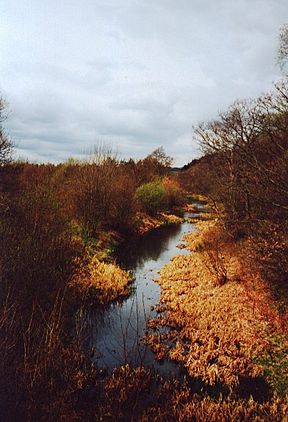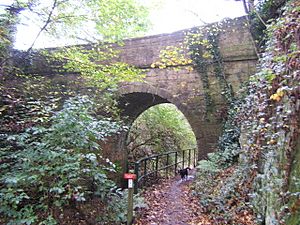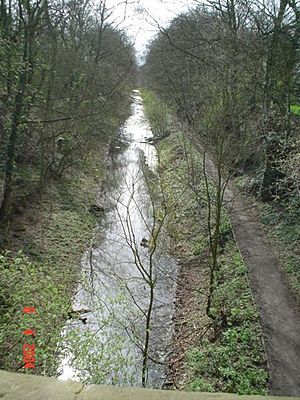Barnsley Canal facts for kids
The Barnsley Canal was a waterway in South Yorkshire, England. It connected Barnby Basin, near Barnsley, to the Aire and Calder Navigation close to Wakefield. Built in the 1790s, its main purpose was to transport coal from Barnsley to a wider market.
Two other canal companies were very interested in this project. The Aire and Calder Navigation bought many shares in the new canal. The River Don Navigation built the Dearne and Dove Canal to link up with the Barnsley Canal. Getting enough water was a problem for the canal. Instead of using steam pumps to get water from the River Calder, a large reservoir was built at Cold Hiendley. This made building the canal more expensive but cheaper to run. The canal was about 14.5 miles (23.3 km) long and had 15 locks.
At first, coal came from the Barnby Furnace colliery. But this mine closed in 1806. The canal company then had little money and not much traffic. Over time, new tramways were built to other mines. This brought more traffic, and the company started making a profit by 1810. Between 1828 and 1830, many bridges were raised. This allowed bigger boats, called "Billy-boys," to use the canal.
In the 1840s, railways arrived in the area. This caused canal traffic to drop quickly. However, the Aire and Calder Navigation took over the canal in 1856. Even with railway competition and damage from ground sinking (subsidence), the canal stayed profitable until 1942. The locks below Cold Hiendley were made longer between 1879 and 1881. The last part of the canal, including five locks at Barugh, closed in 1893.
A big break in the canal happened in 1911. This closed the canal for almost a year. More breaks happened in 1945 and 1946. The Aire and Calder company asked to close the canal for good in 1947. Despite protests from the new Inland Waterways Association, permission was given in 1953. The bridge (aqueduct) over the River Dearne was taken down right away. In 1984, the Barnsley Canal Group was formed. They wanted to see the canal restored. This group later became the Barnsley, Dearne and Dove Canal Trust in 2000. They are now part of a group called the Barnsley Canal Consortium. A study they ordered showed that restoring the canal is possible. If restored, the canal would need three small changes from its original path. These would be at Walton locks, near Cold Hiendley reservoir, and where it crosses the River Dearne.
Contents
History of the Canal
The early 1790s saw a big need for coal. But there wasn't enough coal in many places. This was because industries near the mines used most of it. There was a lot of coal near Barnsley. However, there were no good ways to transport it to other areas.
In July 1792, the Aire and Calder Navigation company looked into building a link. This link would go from near Wakefield to the Barnsley mines. The River Don Navigation company heard about this. They suggested their own idea. It involved making the River Dearne suitable for boats to reach the same area. The Aire and Calder company thought the canal would bring lots of trade. Coal and goods would go from Barnsley to the Aire and Calder. Farm lime would come back from Knottingley.
Engineers surveyed the route. At a meeting in September 1792, canal engineer William Jessop said the canal could be built for about £50,000. The Aire and Calder decided to invest £20,000. This made sure they owned most of the company. In October, the cost was updated to £60,000. Eighty-six people had agreed to invest. The River Don company also attended. They wanted to use the Barnsley to Silkstone route for their Dearne and Dove Canal. An agreement was made. The Barnsley Canal company would build the Barnby to Barnsley part. But they would not take water from the River Dearne. This water was needed for the Dearne and Dove canal. A 2.5-mile (4.0 km) branch was added to the plan. It would go from Barugh to Haigh Bridge. This branch would need seven extra locks.
The Aire and Calder company first planned to pump all the water for the canal. They would use steam pumps from the River Calder. These pumps would be at Agbrigg, Walton, and Barugh. The Haigh branch would have needed a fourth pump. But the Haigh furnace closed, so this branch was never built. A reservoir at Cold Hiendley replaced the pumps at Walton and Agbrigg. This made building the canal £3,000 more expensive. But it saved £350 a year in running costs. An Act of Parliament was passed on June 3, 1793. This law created the company. It allowed them to raise £72,000 by selling shares. They could raise an extra £25,000 if needed. The Dearne and Dove canal was also approved on the same day.
Building the Canal
Construction began on September 27, 1793. Work started at Heath Common, near the Aire and Calder Canal. Samual Hartley was the engineer. John Pinkerton was hired to build the canal. Building was hard. Pinkerton found unexpected rock at Cold Hiendley. Also, prices went up, increasing costs. Hartley and Pinkerton had disagreements. These lasted until 1812, after a lawsuit. The northern part to Barnsley opened on June 8, 1799. The Barnsley to Barnby section started later in 1798. It finally opened in early 1802. The Dearne and Dove Canal was finished in late 1804.
The canal cost £95,000 to build. The original plan included tramways to connect to coal mines. But none of these were built at first. Important engineering parts included a five-arched bridge (aqueduct) over the River Dearne. There was also a long cut at Cold Hiendley. There were five locks at Barugh, twelve at Walton, two at Agbrigg, and one near Heath. This last lock often filled with rubbish. So, a new lock was built closer to the Aire and Calder in 1816.
The Wintersett reservoir was 80 acres (32 ha) when first built. It grew to 127 acres (51 ha) when its banks were raised by 4 feet (1.2 m) in 1807. In 1803, a pumping station was built at Ryhill. It used a large steam engine. This engine pumped extra water from the canal up into the reservoir. Land for a second reservoir at Cold Hiendley was bought in 1840. It was built in 1854. This reservoir was between Wintersett Reservoir and the canal. But it was lower. The pumping station was changed so water could also be pumped from the new reservoir into the canal. The Cold Hiendley reservoir was made bigger to 55 acres (22 ha) in 1874. The old steam engine, likely used before 1803, worked well. It lasted until the canal closed in 1946.
Canal Traffic
The canal was mainly built to carry coal. This coal came from mines in the Barnby area. The Low Moor Company had a mine at Barnby Furnace. They built a 0.5-mile (0.80 km) long railway (waggonway) to Barnby basin. Coal was moving by 1802. By 1804, about 10,000 tons left the mine. The Dearne and Dove Canal had opened in late 1803. Only about half of the coal went the whole way to the Aire and Calder. Coal from the Silkstone mines was not steady. The railway planned by the law was not built due to money problems. The Barnby Furnace mine failed in May 1807. The canal company then had no money and little traffic.
They got a new law passed on March 28, 1808. This allowed them to raise another £43,000 in shares. They could also borrow £10,000. They were also able to charge higher fees (tolls). The Silkstone Waggonway was finished in 1810. Barnby basin was made larger for the expected trade. Trade grew steadily. In 1800, coal was only 23 percent of the 22,270 tons carried. By 1821, it was 109,945 tons out of 181,063 tons. Other main goods were corn and limestone. Money earned also went up. It rose from £2,028 in 1803 to £7,649 in 1821. An extra £2,094 came from railway tolls. Profits were good enough to pay investors from 1810.
To keep boats moving, the Barnsley Canal Company tried to take water from the River Dearne. The River Don Navigation Company, who supported the Dearne and Dove Canal, ordered them to stop. A compromise was reached in 1812. This allowed some Dearne water for the Barnsley canal. Between 1828 and 1830, many bridges were raised. This let larger boats, called "Billy-boys," use the canal.
Facing Competition
Railways started to compete with the canal in the 1840s. At first, the canal company welcomed some railway plans. But the Don Navigation Company wanted to rent and then buy the canal in 1845. They wanted to stop railways from getting to the Silkstone coal. They also wanted to protect water supplies. They quickly offered to give the canal to the Aire and Calder Company. They also offered to buy the Dearne and Dove Canal. They did take over the Dearne and Dove Canal from January 1, 1846. But they dropped their plans for the Barnsley Canal.
The Barnsley Canal Company then tried to arrange a lease with the Aire and Calder. But talks failed. Many talks happened with railway companies and the Aire and Calder Navigation. This was between 1846 and 1853. It wasn't until 1854 that the company agreed to a lease from the Aire and Calder. By then, traffic was falling fast. The takeover was made official by a law in 1856. The Barnsley Canal Company was not closed down. It continued to collect the rent from the lease.
By lowering tolls, the Aire and Calder increased traffic. It went from 179,295 tons in 1855 to 291,313 tons in 1863. But traffic slowly went down after that. This was because railway lines to the coalfields were built. The canal's structures were more and more affected by ground sinking (subsidence) from mining. An inspection of the aqueduct in 1866 showed cracks. In 1870, Barnsley Corporation told the canal company to stop taking water from the River Dearne. They needed the water supply. The Barnsley and Aire and Calder companies talked. This led to the Barnsley Canal Transfer Act of 1871. This law allowed the Aire and Calder to take over the canal. It also allowed replacing ten of the twelve Walton locks with a sloping ramp. It also protected the water supply at Barugh.
The locks below Cold Hiendley were made longer. They went from 66 feet (20 m) to 84 feet (26 m) between 1879 and 1881. But by this time, there was little traffic on the upper part. The last 1.3-mile (2.1 km) section to Barnby, including the five locks at Barugh, was closed. This happened under the Aire and Calder Act 1893. Plans to build the sloping ramp were renewed in 1889. But it was never built. Despite railway competition, the canal still carried over 200,000 tons each year between 1885 and 1909.
The Canal's Decline
A big break in the canal happened on November 20, 1911. Ground sinking (subsidence) caused part of the aqueduct and nearby bank to fail. Repairs finished on July 10, 1912, when the canal reopened. The canal had to close for four months in late 1922 because of a drought. In 1934, the County Council put in an electric lift bridge at Royston.
Traffic kept falling. Maintenance costs went up as subsidence damaged the canal. But the canal remained profitable until 1942. The next year, the Royston bridge was opened 856 times for boats. Mottram Wood colliery flooded on June 13, 1945. This happened when another leak occurred near the aqueduct. In 1946, 53 million imperial gallons (240,000 m3) of water escaped from the canal on November 22. This flooded a housing area and the countryside.
The Aire and Calder asked to close the canal for good in May 1947. The new Inland Waterways Association wanted to keep it open. But the Docks and Inland Waterways Executive (DIWE) doubted if it was good for the country to fix the canal. The DIWE then offered money to boat companies affected by the closure. The order to close the canal was finally given in 1953. The aqueduct was taken down right away. It was thought to be unsafe.
Restoring the Canal
The path of the canal below Barugh has mostly stayed the same. In April 1984, the Barnsley Canal Group was formed. Their goal was to campaign for the canal's restoration. Their first job was to survey the canal. This was to confirm that restoring it was even possible. The group became a company and a charity in April 1991. Then, in June 2000, it became the Barnsley, Dearne and Dove Canal Trust.
In May 2001, the Barnsley Canal Consortium was formed. This group includes local councils, the Inland Waterways Association, and the Canal Trust. The Consortium hired engineers in August 2004. They studied if both the Barnsley Canal and the Dearne and Dove Canal could be reopened. Their report came out in November 2006. It confirmed that restoration was possible.
The restored canal would follow its original path from the Aire and Calder Navigation to Barnsley. A new marina would be built near where the Barugh locks used to be. Three changes to the original route would be needed. One would be at the bottom of the Walton locks. Another would be near Cold Hiendley reservoir. The third would be where the canal crosses the River Dearne, because the original aqueduct is gone.
In 2019, a public meeting was held about Barnsley Metropolitan District Council's local plan. The council suggested not including a firm line for the restored canal. This decision was supported by the inspector. Because of this, and fewer new members, and the impact of the coronavirus pandemic, the Trust decided to stop operating in April 2020. The meeting to make this official was delayed due to the pandemic. They plan to give their assets to the Chesterfield Canal Trust. The Chesterfield Canal Trust will also keep the Barnsley Canal Trust's website online for several years.
Places of Interest
| Point | Coordinates (Links to map resources) |
OS Grid Ref | Notes |
|---|---|---|---|
| Jn with Aire & Calder Navigation | 53°40′31″N 1°28′22″W / 53.6752°N 1.4728°W | SE349199 | |
| Agbrigg bottom lock | 53°40′10″N 1°28′08″W / 53.6694°N 1.4688°W | SE351193 | |
| Walton bottom lock | 53°39′21″N 1°27′45″W / 53.6558°N 1.4624°W | SE356178 | |
| Walton top lock | 53°38′41″N 1°27′19″W / 53.6446°N 1.4552°W | SE361165 | |
| Cold Hiendley Reservoir | 53°37′39″N 1°26′55″W / 53.6274°N 1.4485°W | SE365146 | |
| Shaw Bridge (diversion reqd) | 53°35′10″N 1°26′24″W / 53.5862°N 1.4399°W | SE371101 | |
| Jn with Dearne and Dove Canal | 53°33′25″N 1°27′51″W / 53.5569°N 1.4641°W | SE355068 | |
| Barugh bottom lock | 53°34′33″N 1°31′16″W / 53.5757°N 1.5212°W | SE318089 | |
| Barby Basin | 53°34′04″N 1°32′25″W / 53.5677°N 1.5402°W | SE305079 |





